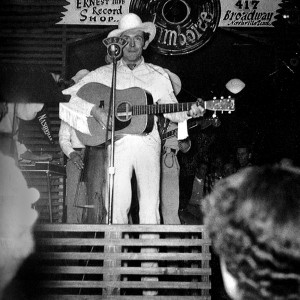The Hillbilly Shakespeare
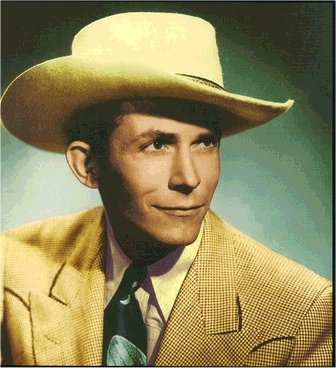 By time of his death in January of 1953, Hank Williams had become the voice for the experience of many rural folk, who had moved to Alabama’s urban centers in search of jobs in the ‘30s and ‘40s. Hank sang of loneliness and a sense of displacement; of the romantic disappointments and honky-tonk intrigues which transpired daily in his world. His songs have been called “white man’s blues,” a mixture of country, blues, folk and gospel elements culled from his childhood.
By time of his death in January of 1953, Hank Williams had become the voice for the experience of many rural folk, who had moved to Alabama’s urban centers in search of jobs in the ‘30s and ‘40s. Hank sang of loneliness and a sense of displacement; of the romantic disappointments and honky-tonk intrigues which transpired daily in his world. His songs have been called “white man’s blues,” a mixture of country, blues, folk and gospel elements culled from his childhood.
Hank Williams is considered by many to be the father of contemporary country music. Within an amazingly short recording career, between 1947 and 1953, he had thirty-seven Top Ten hits. In less than four years, between March of 1949 and his death in 1953, his songs spent an astounding eighty-two weeks at Number One on the charts. At a time when Elvis Presley was a still just a schoolboy, Hank Williams was gyrating suggestively onstage; flashing flirtatious eyes at every woman in the room.
Still, in many ways, his tragically brief career, mirrored that of a debauched rock star. He was a music legend by the time he reached age twenty-five. Addicted to booze and drugs, he was dead before he reached age thirty. Yet, in that short period of time, he created a body of work that was to became classic in the lexicon of popular music. He was called the Hillbilly Shakespeare, the Backwoods Troubadour, the Honky-Tonk Poet. His simple melodies, direct, emotional lyrics and evocative vocals became customary for most popular performers, across all genres. At the same time, he lived a life as wild and unrestrained as that portrayed in many of his songs.
Hiram King Williams was born in the lumber town of Mount Olive West, Alabama, north of Birmingham, on September 17, 1923; the second child of Elonzo Huble and Jessie Lilly Belle Skipper Williams. Hiram was born with a mild form of spina bifida: a disorder involving the incomplete development of the spinal cord; a painful condition, which would plague him for the rest of his life.
Lonnie Williams worked as a strawberry farmer and a log trimmer; whereas Lilly Williams worked as a seamstress and nurse, while serving as organist for the local Baptist church. Years later, Hank Williams recalled that his very first memory was of watching his mother play the organ. When Hiram was six years old, Lonnie was taken to a veteran’s hospital in Louisiana with a diagnosis of dementia. This left Lilly to raise Hiram and his sister Irene on the twenty-five cents a day she was earning at the time. After the family home in Mount Olive burned down, Lilly moved the family to Georgiana, Alabama, about fifty miles south of Montgomery.
Hoping that the instrument might lead to a career as a musician for her son, Lilly Williams, a rather stern and strong-willed woman, gave eight year-old Hiram a secondhand Silvertone guitar, which she purchased for $3.50- a relatively significant sum during the days of the Great Depression. Hiram’s musical education was provided by a local blues street singer, Rufus Payne, who was known around Georgiana as Tee Tot.
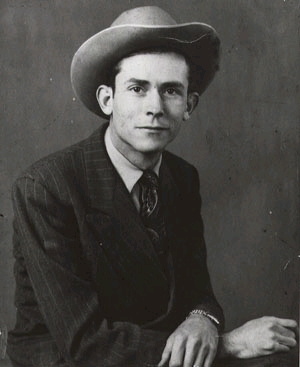 From Tee Tot, Hiram learned how to play the guitar and sing the blues- which would one day provide a strong foundation for his songwriting. In interviews twenty-five years later, Hank Williams acknowledged Rufus Payne’s instruction as an early influence in his life. Eventually the pair began performing together around Georgiana and Greenville, fifteen miles north, for house parties, dances and other functions.
From Tee Tot, Hiram learned how to play the guitar and sing the blues- which would one day provide a strong foundation for his songwriting. In interviews twenty-five years later, Hank Williams acknowledged Rufus Payne’s instruction as an early influence in his life. Eventually the pair began performing together around Georgiana and Greenville, fifteen miles north, for house parties, dances and other functions.
Lilly moved the family to Greenville in 1934, a city substantially larger than the small town of Georgiana. Hiram and Irene started school in Greenville in September of that year. Several of his classmates from that time recall Hiram bringing his guitar to school, where would practice during lunch and after school- telling friends that playing and singing were his highest ambitions.
Then, in 1937, Lilly moved Hiram and Irene to Montgomery, Alabama, where she opened a boarding house. Hiram sold peanuts on the street, singing to attract customers. E. Caldwell Stewart, music director at WSFA Radio, which broadcast from the Jefferson Davis hotel, claimed that he heard Hiram singing one day and ran a microphone down to the street to capture the teenager’s music. At some point, “Hank” Williams began singing occasionally on WSFA, a career that was to continue, intermittently, as long as he lived in Montgomery.
For the Christmas of 1937, Lilly bought Hank a new Gibson guitar, purchased at a music store in downtown Montgomery. Within a few weeks, he won an amateur talent show in Montgomery, singing his own composition, “WPA Blues.” Shortly thereafter, fourteen year old Hank met Montgomery musician Braxton Schuffert, who was already a popular radio personality. With Schuffert on guitar, bassist Smith “Hezzy” Adair, fiddler Freddy Beach and sister Irene Williams on back-up vocals, Hank formed the band the Drifting Cowboys. They played clubs, square dances and parties, as well as in more unconventional venues, such as dance marathons. Though he played regular engagements around the area, Hank’s music was not particularly well-received by Montgomery’s landed gentry.
Still he became something of a sensation in the local clubs. With Lilly booking the engagements, the band began playing at working class bars such as the Golden Nugget and the Spur Club in Montgomery and Thigpen‘s Log Cabin back in Georgiana. These clubs were honky-tonks. They catered to working class people who had moved to the city from rural areas, to find employment at the north Montgomery industrial plants, at Dr. Pepper Bottling, or the glass works in Boyleston; or for the railroad. At the end of their day, those rough and tumble laborers sought libations and entertainment at nearby juke joints. The colloquial term for such honky-tonks was “blood buckets,” because of the bloodshed which regularly erupted in those establishments.
The stages at such places were routinely enclosed within chicken wire, in order to protect the musicians from various projectiles- which included, but was not limited to bottles, chairs and human beings. The honky-tonks were so tough, that, for a while, Hank hired a professional wrestler to play bass with the band.
Hank attended Sidney Lanier High School in Montgomery, but, owing to his success in the bars (and, increasingly, on the radio), he dropped out of school during his sophomore year in 1939. Performing on various local radio shows, he would cover songs recorded by his hero, Roy Acuff, as well as other country hits of the day. WSFA began calling him the “Singing Kid.” Hank remained with the station through much of the ‘40s.
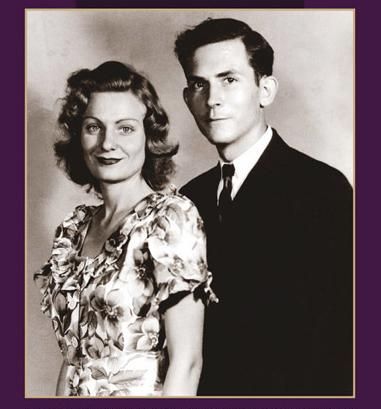 In 1943, while working in a traveling medicine show, Hank met Audrey Mae Sheppard, a recently-divorced farm girl from Banks, Alabama, who had a two-year old daughter named Lycrecia. The following year, the couple married and moved into Lilly’s boarding house in Montgomery. Just before their marriage, Audrey, who harbored a strong desire for a musical career of her own (though she lacked any real talent), replaced Lilly as Hank’s manager. She also learned how to play the stand-up bass, inserting herself into the Drifting Cowboys line-up for a time.
In 1943, while working in a traveling medicine show, Hank met Audrey Mae Sheppard, a recently-divorced farm girl from Banks, Alabama, who had a two-year old daughter named Lycrecia. The following year, the couple married and moved into Lilly’s boarding house in Montgomery. Just before their marriage, Audrey, who harbored a strong desire for a musical career of her own (though she lacked any real talent), replaced Lilly as Hank’s manager. She also learned how to play the stand-up bass, inserting herself into the Drifting Cowboys line-up for a time.
Hank was becoming increasingly popular in the region. But, in a pattern which was to repeat itself throughout the course of his life, he was often his own worst enemy- drinking heavily and frequently failing to show up for appearances. As with his life, his career was a constantly swinging pendulum. WSFA fired him for his unreliability, but took him back in early 1946.
That same year, Hank and Audrey visited Nashville with the sole intention of meeting Fred Rose, one of the partners in Acuff-Rose Publishing. Rose liked Hank’s material, requesting he record a few songs for Sterling Records- which resulted in two singles- “Never Again,” released in December 1946, and “Honky Tonkin’,” released in February 1947. The success of both songs led to a contract with MGM records a few months later; at which point Rose became Hank’s manager and record producer.
Released later in 1947, Hank’s first single for MGM, “Move It on Over,” was an immediate hit, climbing into the Top Five of the country charts. But, never one to entirely embrace success, Hank’s chronic alcoholism led Rose to temporarily resigning as his manager; while Audrey contemplated divorce. Hank managed to pull out of his tailspin, but, in many ways, the die had been cast.
By the summer of 1948, he was back to performing, on tour and radio with the Louisiana Hayride. “Honky Tonkin’” was released in 1948, followed by “Mansion On The Hill” and “I’m a Long Gone Daddy.” All three songs found modest success, with the latter reaching the Top Ten. Early in 1949, Hank released “Lovesick Blues,” an oft-recorded Tin Pan Alley number. The single became a huge hit in the spring of 1949, remaining at Number One for sixteen weeks, while crossing over into the Top Forty of the pop charts. Hank sang “Lovesick Blues” in his first performance at the Grand Ole Opry, for which he was accorded an unprecedented six encores. After over a decade of struggle and discouragement, Hank Williams had finally become a star.
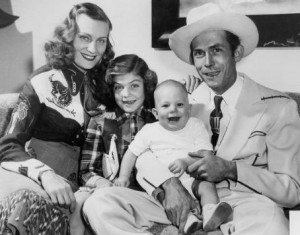 Audrey and Hank had their first child, Randall Hank (Hank Williams Jr.), in the spring of 1949. Later that spring, Hank assembled the best remembered version of the Drifting Cowboys, featuring guitarist Bob McNett, bassist Hillous Butrum, fiddler Jerry Rivers, and steel guitarist Don Helms. Soon, he and the band were earning over one thousand dollars per concert; with sold-out shows across the country.
Audrey and Hank had their first child, Randall Hank (Hank Williams Jr.), in the spring of 1949. Later that spring, Hank assembled the best remembered version of the Drifting Cowboys, featuring guitarist Bob McNett, bassist Hillous Butrum, fiddler Jerry Rivers, and steel guitarist Don Helms. Soon, he and the band were earning over one thousand dollars per concert; with sold-out shows across the country.
Following “Lovesick Blues” Hank released seven more hits through 1949-50, including “Wedding Bells,” “I’m So Lonesome I Could Cry,” “Mind Your Own Business,” “You’re Gonna Change (Or I’m Gonna Leave),” and “My Bucket’s Got a Hole in It” (a song he learned from Tee-Tot) in 1949, all of which reached the Top Five. He also had a string of hit singles in 1950, including the Number One hits “Long Gone Lonesome Blues,” “Why Don’t You Love Me,” and “Moanin’ the Blues,” as well as the Top Ten hits “I Just Don’t Like This Kind of Livin’,” “My Son Calls Another Man Daddy,” “They’ll Never Take Her Love From Me,” “Why Should We Try,” and “Nobody’s Lonesome for Me.” That same year, Hank began recording a series of spiritual records under the name Luke the Drifter.
He continued to top the charts in 1951, beginning with the Number One single “Cold, Cold Heart,” and the Top Ten flip-side, “Dear John.” That same year, pop vocalist Tony Bennett recorded “Cold, Cold Heart.” It became a huge hit, leading many other mainstream artists to cover Hank’s songs. Hank had several other hits of his own in 1951, including the Number One “Hey, Good Lookin’.” “Howlin’ at the Moon,” “I Can’t Help It (If I’m Still in Love With You),” “Crazy Heart,” “Lonesome Whistle,” and “Baby, We’re Really in Love,” also charted in the Top Ten that year.
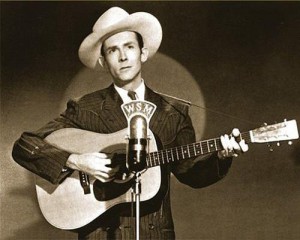 Though his professional career was soaring, Hank’s personal life was beginning to free fall. His marriage to Audrey was in a state of rapid collapse. His crippling alcoholism had spiraled out of control. To make matters worse, in the Fall of 1951, while Hank was hunting on his Tennessee farm, he tripped and fell, aggravating his back condition. He began taking morphine and other pain killers for the injury, to which he quickly became addicted.
Though his professional career was soaring, Hank’s personal life was beginning to free fall. His marriage to Audrey was in a state of rapid collapse. His crippling alcoholism had spiraled out of control. To make matters worse, in the Fall of 1951, while Hank was hunting on his Tennessee farm, he tripped and fell, aggravating his back condition. He began taking morphine and other pain killers for the injury, to which he quickly became addicted.
In January of 1952, Hank and Audrey separated for a final time. At loose ends, he returned to Montgomery to live with his mother. Yet, at the same time, the hits were still mounting, with “Honky Tonk Blues” peaking at Number Two in the spring. He released five more Top Ten singles in 1952 — “Half as Much,” “Jambalaya,” “Settin’ the Woods on Fire,” “You Win Again,” and “I’ll Never Get Out of This World Alive.” Despite his success, his destructive behavior continued to escalate. Hank spent nearly every waking hour drunk, or taking drugs.
He left his mother in early spring, moving in with country singer Ray Price in Nashville. In May, Audrey and Hank were officially divorced. Hank continued a grueling schedule of concerts, but, increasingly, he would perform drunk, or miss shows altogether. In August of 1952, the Grand Ole Opry fired him for his erratic behavior. He was told that he could return once he quit drinking. That opportunity never arrived.
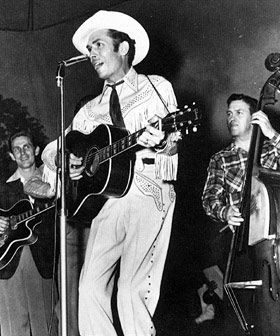 Hank only spun deeper into his nosedive. Soon, his friends were deserting him. The Drifting Cowboys began working with Ray Price. Fred Rose abandoned him, once and for all. Hank still regularly played the Louisiana Hayride, but he was increasingly reduced to performing at small clubs with local pickup bands; greatly reducing his remuneration.
Hank only spun deeper into his nosedive. Soon, his friends were deserting him. The Drifting Cowboys began working with Ray Price. Fred Rose abandoned him, once and for all. Hank still regularly played the Louisiana Hayride, but he was increasingly reduced to performing at small clubs with local pickup bands; greatly reducing his remuneration.
That fall, he met Billie Jean Jones Eshlimar, the nineteen year-old daughter of a Louisiana policeman. By October, they were married. At the same time, Hank signed an agreement to support the unborn baby of one of his other girlfriends, Bobbie Jett. By the end 1952, Hank was beginning to suffer from symptoms of congestive heart failure. Hank hired a quack doctor, Toby Marshall, who prescribed sedative chloral hydrate tablets, in an effort to help Hank overcome his drinking problem.
Hank was scheduled to play a concert in Canton, Ohio, on January 1, 1953. He was scheduled to fly out of Knoxville, Tennessee, on New Year’s Eve, but the weather was so inclement, he was forced to hire an Auburn University student to drive him to Ohio in his new Cadillac. Before they left for Ohio, Hank was injected with two shots of vitamin B-12 and morphine by yet another doctor. He got into the backseat of the Cadillac with a bottle of whiskey and a pocket full of chloral hydrate tablets, while his driver headed for Canton.
When the driver was stopped for speeding, the arresting officer casually remarked that the man in the back seat looked dead. Upon finding that Hank’s body was cold to the touch, the teenaged driver rushed Hank to a hospital in Oak Hill, West, Virginia where he was officially declared dead at 7:00 a.m. on January 1, 1953. Ironically, the last single released during his lifetime was “I’ll Never Get Out of This World Alive.”
Three days later Hank Williams was buried in Montgomery, Alabama. His funeral drew over twenty thousand mourners, larger than any crowd gathered in Alabama since Jefferson Davis was inaugurated as the President of the Confederacy in 1861. Dozens of country music stars attended the service, as did Audrey Williams, Billie Jean Jones, and Bobbie Jett, who gave birth to Hank’s daughter three days later. “I’ll Never Get Out of This World Alive” reached Number One immediately after his death. It was followed by a string of hit records throughout 1953, “Your Cheatin’ Heart,” “Kaw-Liga,” and “Take These Chains From My Heart” all reached Number One on the charts. In 1961, Hank was one of the first inductees to the Country Music Hall of Fame. In 1987 he was elected to the Rock and Roll Hall of Fame.
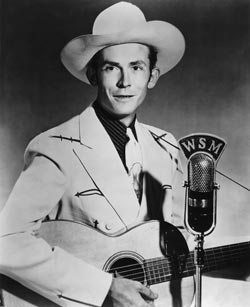 Hank Williams reigns as one of the defining voices of popular music. During his lifetime he recorded one hundred and thirty songs. Those songs, which deftly articulated his preoccupations with mortality and the futility of interpersonal relationships, reflected the lives and feelings of his fans and stand as true masterpieces of their form. His recordings remain, to this day, integral and pertinent examples of the craft. His mercurial life could rival the works of William Shakespeare himself for sheer drama and complexity. His life stands as an enduring legend, his music as golden threads in the fabric of our lives.
Hank Williams reigns as one of the defining voices of popular music. During his lifetime he recorded one hundred and thirty songs. Those songs, which deftly articulated his preoccupations with mortality and the futility of interpersonal relationships, reflected the lives and feelings of his fans and stand as true masterpieces of their form. His recordings remain, to this day, integral and pertinent examples of the craft. His mercurial life could rival the works of William Shakespeare himself for sheer drama and complexity. His life stands as an enduring legend, his music as golden threads in the fabric of our lives.

